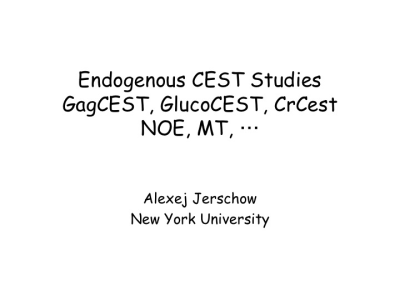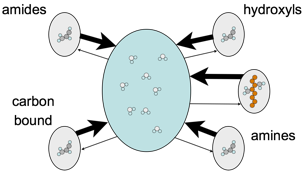|
Weekend Educational Course
Probing Biomolecules: Magnetic Susceptibility & CEST/MT |
|
Probing Biomolecules: Magnetic Susceptibility & CEST/MT: Part 1
Weekend Course
ORGANIZERS: Chunlei Liu, Peter van Zijl, Elena Vinogradov
Sunday, 17 June 2018
| N01 |
13:15 - 14:45 |
Moderators: Jongho Lee, Elena Vinogradov |
Skill Level: Intermediate
Session Number: WE-26A
Overview
Both magnetic susceptibility and magnetization transfer are related to resonance frequencies of biomolecules. After presentation of some basic background principles on magnetic susceptibility and magnetization transfer properties in tissue (two talks), an overview will be given on how these properties can be measured quantitatively in vivo (two talks), followed by four talks covering the in vivo properties and possible applications for susceptibility mapping and possible probes and endogeneous application for CEST imaging.
Target Audience
Scientists and clinicians interested in quantifying tissue properties, such as iron and myelin with susceptibility imaging, and those interested in assessing metabolite imaging or designing probes for CEST MRI.
Educational Objectives
As a result of attending this course, participants should be able to:
-Describe the magnetic susceptibility properties of tissue;
-Explain exchange transfer and dipolar transfer as used in conventional magnetization transfer;
-Summarize how to map susceptibility and CEST properties; and
-Discuss early clinical applications of CEST and susceptibility MRI.
13:15
|
|
 Paramagnetic & Diamagnetic Susceptibility in Tissue Paramagnetic & Diamagnetic Susceptibility in Tissue
Ferdinand Schweser
This class will discuss the chemistry and physics of magnetic susceptibility, explaining why some substances affect tissue susceptibility substantially when they are present in very low concentrations whereas other substances need to be present in high concentrations to alter the tissue’s susceptibility measurably. We will discuss the how and why of the differential effects of magnetic susceptibility on gradient-echo magnitude and phase image contrast. An overview of the clinical potential of Quantitative Susceptibility Mapping (QSM) will be provided by discussing the different tissue properties that have been related to magnetic susceptibility in the more recent past.
|
13:37
|
 |
 Magnetization Transfer: MTC, NOE, CEST Magnetization Transfer: MTC, NOE, CEST
Alexej Jerschow
The aim of this presentation is to give the MRI practitioner a good overview of the methods used in CEST and MT imaging, the underlying mechanisms, the current state of the art, and to outline the opportunities and limitations of the methods.
|
13:59
|
|
 Tissue Magnetic Susceptibility Mapping (QSM) Tissue Magnetic Susceptibility Mapping (QSM)
Barbara Dymerska
|
14:21
|
 |
 What Are We Really Measuring in CEST? What Are We Really Measuring in CEST?
Daniel Gochberg
This talk will examine the underlying drivers of the CEST signal, and it will discuss the implications for choosing CEST pulse sequences and metrics that maximize solute specificity.
|
14:43
|
|
Break & Meet the Teachers |
|
| |
|
Probing Biomolecules: Magnetic Susceptibility & CEST/MT: Part 2
Weekend Course
ORGANIZERS: Chunlei Liu, Peter van Zijl, Elena Vinogradov
Sunday, 17 June 2018
| N01 |
15:15 - 16:43 |
Moderators: Jongho Lee, Elena Vinogradov |
Skill Level: Intermediate
Session Number: WE-26B
Overview
Both magnetic susceptibility and magnetization transfer are related to resonance frequencies of biomolecules. After presentation of some basic background principles on magnetic susceptibility and magnetization transfer properties in tissue (two talks), an overview will be given on how these properties can be measured quantitatively in vivo (two talks), followed by four talks covering the in vivo properties and possible applications for susceptibility mapping and possible probes and endogeneous application for CEST imaging.
Target Audience
Scientists and clinicians interested in quantifying tissue properties, such as iron and myelin with susceptibility imaging, and those interested in assessing metabolite imaging or designing probes for CEST MRI.
Educational Objectives
As a result of attending this course, participants should be able to:
-Describe the magnetic susceptibility properties of tissue;
-Explain exchange transfer and dipolar transfer as used in conventional magnetization transfer;
-Summarize how to map susceptibility and CEST properties; and
-Discuss early clinical applications of CEST and susceptibility MRI.
15:15
|
|
 Susceptibility Anisotropy Susceptibility Anisotropy
Richard Bowtell
|
15:37
|
|
 CEST MRI of Biomolecules CEST MRI of Biomolecules
Kannie WY Chan
Chemical Exchange Saturation Transfer (CEST) MRI allows us to access molecular information with an enhanced sensitivity. Various contributing proton exchange mechanisms provide ample information for imaging biomolecules and their related pathophysiology. This molecular contrast is sensitive to alterations of exchanging environments in vivo, e.g. CEST contrast of proteins in the brain is different from that in brain tumors with acidic pH. Thus, CEST contrast characterized by the z-spectrum provides readouts for comprehensive physiological and molecular assessments. This talk will present CEST imaging of biomolecules in the brain, and its applications, challenges and opportunities in studying brain tumors and neurological disorders.
|
15:59
|
|
 QSM Clinical Applications QSM Clinical Applications
Yukunori Korogi
The QSM values of the substantia nigra were significantly higher in PD patients than in healthy subjects. QSM showed higher diagnostic performance than R2* mapping for the discrimination between PD patients and controls. The QSM value in GPl increases gradually with age, which allows for the identification of GPm in elderly PD subjects. QSM can detect the abnormalities in normal-appearing basal ganglia in patients with neuropsychiatric systemic lupus erythematosus (NPSLE), which likely represents increased iron deposition.
|
16:21
|
|
 CEST Almost Clinical Applications CEST Almost Clinical Applications
Seth Smith
The goal of this educational presentation is to discuss the important contributions that CEST MRI can have for clinical-translational studies, by highlighting the unique contrasts available and examining the current applications of CEST MRI in the literature. We will further discuss the potential limitations for more clinically viable adoption of CEST and discuss the opportunities to overcome these limitations, including some studies that have begun to take the clinical leap. We will close by discussing the potential impact of a unique contrast to clinical-translational studies of the human condition.
|
16:43
|
|
Adjournment & Meet the Teachers |
|
| Back |
| The International Society for Magnetic Resonance in Medicine is accredited by the Accreditation Council for Continuing Medical Education to provide continuing medical education for physicians. |



